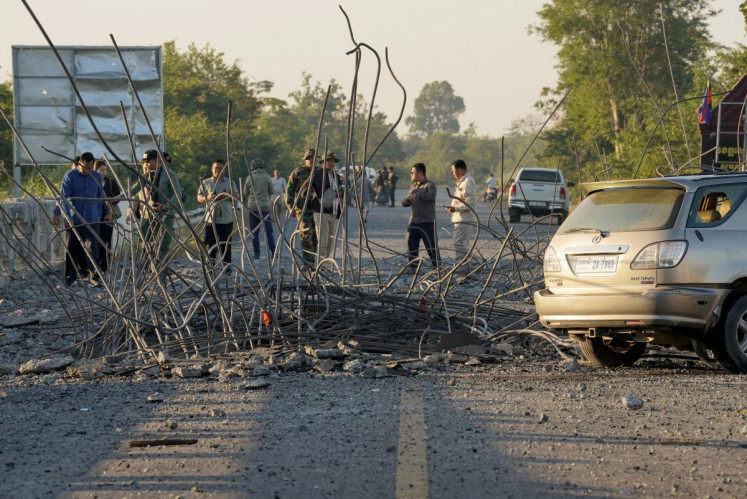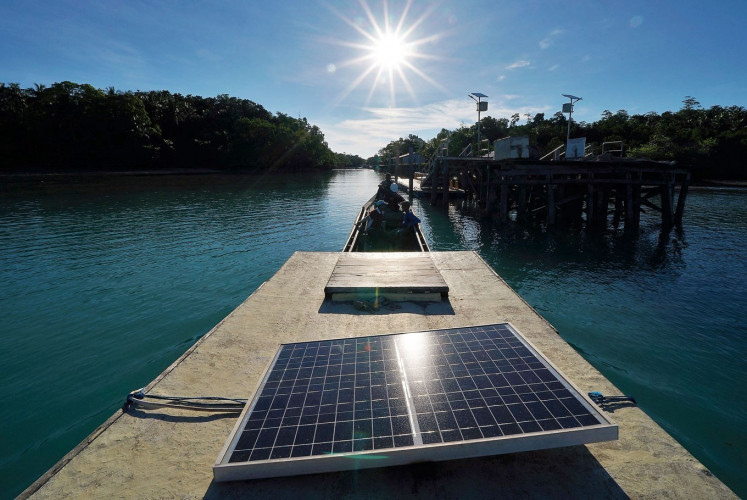Popular Reads
Top Results
Can't find what you're looking for?
View all search resultsPopular Reads
Top Results
Can't find what you're looking for?
View all search resultsRI COVID-19 death rate now higher than India’s second wave
But now, 12 days since the stricter restrictions were imposed in many parts of Indonesia, efforts to curb infections are still falling woefully short of the targets the government has set. All the while, cases and deaths continue to soar.
Change text size
Gift Premium Articles
to Anyone
W
ith the unprecedented numbers of daily new cases and deaths reported in the past week, and a collapsing healthcare system, Indonesia has been looking to India -- which managed to reduce its virus spread within two months -- in the hope that the current nightmare can be brought to an end.
But now, 12 days since the stricter restrictions were imposed in many parts of Indonesia, efforts to curb infections are still falling woefully short of the targets the government has set. All the while, cases and deaths continue to soar.
Indonesia’s daily deaths per million people have dramatically increased since mid-June, from 0.67 on a seven-day rolling average to 3.32 on Wednesday. This is higher than India’s 3.04 when it was at the peak of its second wave in May, according to Our World In Data.
President Joko “Jokowi” Widodo said while announcing the emergency public activity restrictions (PPKM Darurat) earlier this month that he and his ministers had close contacts with their Indian counterparts to learn from their experiences.
Coordinating Economic Affairs Minister Airlangga Hartanto, who chairs the COVID-19 Handling and National Economic Recovery Committee (KPCPEN), even claimed that Indonesia’s response was nearly identical to what India was doing two months ago.
“We have seen the cycle [of Delta variant] in India, how long would this variant go down and the solution we’re implementing is almost the same as what is being done in India,” Airlangga told a press briefing on Friday.
Indonesia is implementing the PPKM Darurat across Java and Bali from July 3 to 20 in a bid to curb the exponential spread of the Delta variant, first discovered in India. The government just on Monday expanded it to 15 other regions where infections are surging.
A document from the Office of the Coordinating Maritime Affairs and Investment Minister, circulating ahead of the PPKM Darurat announcement, referenced the measures implemented in India and Malaysia. It particularly made a point that Malaysia’s targeted lockdown at states, cities and districts level was proven to be more effective than a national lockdown.
Under the PPKM Darurat, all nonessential workers and students must work and study from home, while essential businesses are allowed to operate at 50 percent of their maximum workplace capacity. The new policy also tightens restrictions on community-level mobility, intercity and air travels, and bans dine-in services.
The second waves of cases in both countries are arguably almost identical -- partly fueled by people celebrating religious holidays and their governments which lowered their guards. But Indonesia’s and India’s COVID-19 journeys rarely crossed. When Indonesia was dealing with COVID-19 surge following the New Year holiday in January and February, India reached its lowest daily cases, down to a level of 11,000 cases a day.
Delta variant
When India became the first country hit by the “hypertransmissible” Delta variant and began reporting six-figure daily cases in early April, Indonesia maintained a steady trend at around 5,000 cases per day.
While both countries have been criticized for undercounting their cases, Indonesia’s positivity rate has consistently been so high, having reached below 10 percent only a few times over the course of 16 months since the first cases emerged
The ideal rate according to the World Health Organization is below 5 percent but Indonesia's rate has never come close to that. India, on the contrary, managed to push down its positivity rate to below 5 percent in early June from around 20 percent in late April. The country is now maintaining around 2 percent of positive rate.
Testing and tracing remains Indonesia’s biggest challenge in overcoming the pandemic. While India, according to WHO situation report on Indonesia on June 23 that mentioned lessons learned from India, managed to conduct 5 to 10 tests per week per 1,000 population during the surge.
Indonesia performed around 4.7 tests per 1,000 people per week from July 5 to 11 during the PPKM Darurat, increasing from around 2.5 in the last week of June, although only half of these were PCR tests.
But a closer look at provincial numbers suggests that over half of the provinces reported a testing rate below the WHO ideal benchmark of 1 test per 1,000 people per week, the WHO July 7 situation report on Indonesia showed.
Health Minister Budi Gunadi Sadikin early this month said he was aiming to increase the number of daily tests from around 100,000 to between 400,000 and 500,000 tests. If converted into tests per 1,000 people per week, the increase would be from 2.5 to 12 tests per 1,000 people per week.
Ramping up testing and tracing should be relatively painless, as opposed to mobility restrictions which often come with various socioeconomic effects, said pulmonologist Tjandra Yoga Aditama, who is the director of postgraduate studies at Yarsi University and formerly a WHO director for Southeast Asia region.
“We need to increase our testing, it does not really have any impact on socioeconomic situation, [it] just [needs] a lot of effort, but there is already a clear [widely used] target, which is 1 test per 1,000 people per week,” he said. He was referring to an ideal WHO benchmark for testing.
“We also need to improve tracing, which also has no socioeconomic impacts, and there is also a clear target -- either 30 or 15 contacts traced for every one case,” he said.
Expectation
Coordinating Maritime Affairs and Investment Minister Luhut Pandjaitan on Monday expected that the COVID-19 curve would begin to flatten at around 30,000 new cases a day in the coming week, citing the new measures reduced mobility by 15 to 20 percent.
The senior minister previously said that ideally the mobility should be reduced up to 50 percent in order to curb the Delta variant, and that the government was working to bring daily new cases below 10,000.
Tjandra said in order to decide whether to tighten or relax the measures, the government must follow a monitoring system that was good, accurate and based on scientific data, and if Indonesia wanted to follow India’s footstep, it also meant bracing for more extension of curbs.
India’s capital New Delhi and one of biggest contributors to countrywide infections began implementing a total lockdown, which was admittedly more stringent than PPKM Darurat, on April 19. Originally planned for only a week, it was extended several times.
India's tally continued to increase in the following months, with daily cases peaking at 414,188 on May 6 or roughly three weeks after the lockdown in New Delhi. Parts of the country, for instance, New Delhi and Mumbai, only began gradual easing in early June.
Epidemiologist Dicky Budiman said most of the key indicators in pandemic control, from daily cases to positivity rate and burden on health facilities, were still growing in Indonesia.
"The worst case scenario is that with the current projections we will experience a peak in late July and early August, and that will obviously put more burden on health facilities and increase deaths between 1,000 and 2,000 a day,” he said. He predicted that the real infections could be well above 100,000.
Daily deaths averaged 840 last week and 915 this week, twice hitting over 1,000 a day.










